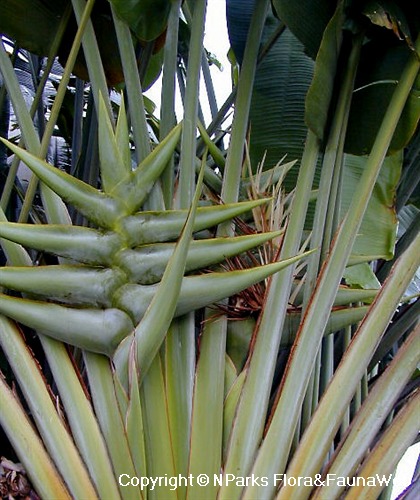
Back
Ravenala madagascariensis Sonn.
| Family Name: | Strelitziaceae |
| Common Name: | Traveller's Palm, Traveller's Tree, Pokok Travelers, Pisang Kipas, 旅人蕉, 扇芭蕉 |
Name
Classifications and Characteristics
| Plant Division | Angiosperms (Flowering Seed Plants) (Monocotyledon) |
|---|---|
| Plant Growth Form | Herbaceous Plant |
| Lifespan (in Singapore) | Perennial |
| Mode of Nutrition | Autotrophic |
| Maximum Height | 9 m to 18 m |
| Maximum Plant Spread / Crown Width | 4.5 m to 5.5 m |
| Tree or Palm – Trunk Diameter | 0 |
Biogeography
| Native Distribution | Madagascar |
|---|---|
| Native Habitat | Terrestrial (Secondary Rainforest, Grassland / Savannah/ Scrubland) |
| Preferred Climate Zone | Sub-Tropical / Monsoonal |
Description and Ethnobotany
| Growth Form | A palm-like plant that can reaches up to 30m height in the wild, but typically shorter in cultivation. |
|---|---|
| Crown | Crown symmetrical, fan-shaped. |
| Trunk | Trunk woody-like with characteristic leaf-scar rings, hidden underground in juvenile plants, and emergent in mature plants. |
| Foliage | Paddle-shaped, banana-like, large (up to 4m long and 0.5m wide), with 2-4m long petioles that terminate in large hollow basal sheaths. |
| Flowers | Small, off-white, in boat-like bracts, produced in inconspicuous inflorescences up to 30cm long amongst leaf petioles, reported to be pollinated by Varecia variegata (Ruffled Lemurs) in native habitat. Blooming seldom observed in Singapore and tropical lowlands due to ever wet conditions. |
| Fruit | Fruits brown, woody, 3-lobed capsules. Seeds numerous, black, thinly covered with glossy blue and hairy aril, eaten by birds. |
| Taxonomy | Monotypic genus (ie. only 1 species within genus). |
| Cultivation | Cultivated in landscapes for its tropical-looking and architectural crown. Can be grown in containers to constrain size. Prefers moist, well-drained, rich loamy soils, and regular nitrogen-rich fertilizers for lusher foliage growth. Avoid planting in areas with strong winds, which may result in torn tattered leaves. If neat formal appearance is desired, remove basal suckers regularly to maintain clear-trunked specimens, and prune away older leaves. Usually propagated by division of suckers from base of parent plant. Untreated seeds slow to germinate. Plant growth initially slow, trunks may take up to 3 years to emerge from underground, but growth rate accelerates thereafter. |
| Etymology | Genus epithet 'Ravenala' derived from native Malagasy name, Ravinala, meaning "leaves of the forest". |
| Ethnobotanical Uses | Others: Common name 'Traveller's Palm' derived from anecdotes that thirsty travellers can obtain up to 1.5 litres of drinking water collected within leaf sheaths. Plant also referred to as a compass for travellers, as it is thought that it always orientates itself along north-south axis, although this is not always true. A possible reason for such a directional orientation is the plant's attempt to face its crown of leaves into the east-west path of the sun, in order to maximize the amount of light captured. Used as emblem of Raffles Hotel, Singapore. |
Landscaping Features
| Desirable Plant Features | Ornamental Flowers, Ornamental Foliage, Ornamental Seeds |
|---|---|
| Landscape Uses | Container Planting, Suitable for Roadsides, General, Focal Plant |
| Plant & Rootzone Preference or Tolerance Remarks | Sandy soil, Clayey soil |
Fauna, Pollination and Dispersal
| Fauna Pollination Dispersal Associated Fauna | Bird-Attracting |
|---|---|
| Pollination Method(s) | Biotic (Fauna) (Vertebrates (Other Mammal), Associated with: Ruffled Lemurs) |
| Seed or Spore Dispersal | Abiotic (Explosive Dehiscence), Biotic (Fauna) |
Plant Care and Propagation
| Light Preference | Semi-Shade, Full Sun |
|---|---|
| Water Preference | Moderate Water |
| Plant Growth Rate | Moderate |
| Rootzone Tolerance | Fertile Loamy Soils, Well-Drained Soils |
| Maintenance Requirements | Moderate |
| Potential Problems | Leaf sheaths and flower bracts may collect stagnant water and are potential mosquito breeding grounds. |
| Propagation Method | Seed, Sucker, Division |
| Propagule Establishment Remarks | Seeds are slow to germinate. |
Foliar
| Foliage Retention | Evergreen |
|---|---|
| Mature Foliage Colour(s) | Green |
| Mature Foliage Texture(s) | Smooth, Glossy / Shiny |
| Foliar Type | Simple / Unifoliate |
| Foliar Arrangement Along Stem | Alternate, Equitant |
| Foliar Shape(s) | Non-Palm Foliage (Oblong) |
| Foliar Venation | Parallel |
| Foliar Margin | Entire |
| Typical Foliar Area | Megaphyll (>1640.25cm2 ) |
| Leaf Area Index (LAI) for Green Plot Ratio | 3.5 (Shrub & Groundcover - Monocot) |
Non - Foliar and Storage
| Trunk Type (Non Palm) | Non Woody |
|---|---|
| Stem Type & Modification | Herbaceous |
| Root Type | Underground (Fibrous Root) |
| Specialised Storage Organ(s) | Underground (Rhizome) |
Floral (Angiosperm)
| Flower & Plant Sexuality | Bisexual Flowers |
| Flower Colour(s) | Cream / Off-White, White |
|---|---|
| Flower Grouping | Cluster / Inflorescence |
| Flower Location | Axillary |
| Flower Size - Remarks | Flowers small, inflorescence up to 30cm across. |
| Ovary Position | Inferior / Epipgynous |
| Flowering Period | Rarely |
| Flower Lifespan on Plant | Several Days |
| Flowering Habit | Polycarpic |
Fruit, Seed and Spore
| Mature Fruit Colour(s) | Brown |
|---|---|
| Fruit Classification | Simple Fruit |
| Fruit Type | Dehiscent Dry Fruit , Capsule |
Image Repository
Others
| Master ID | 1807 |
|---|---|
| Species ID | 3100 |
| Flora Disclaimer | The information in this website has been compiled from reliable sources, such as reference works on medicinal plants. It is not a substitute for medical advice or treatment and NParks does not purport to provide any medical advice. Readers should always consult his/her physician before using or consuming a plant for medicinal purposes. |










